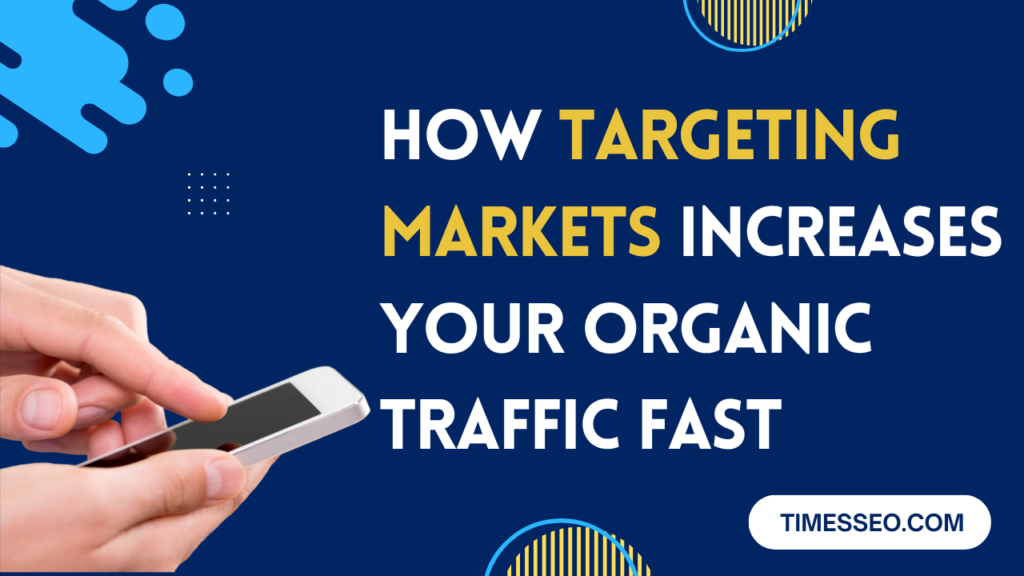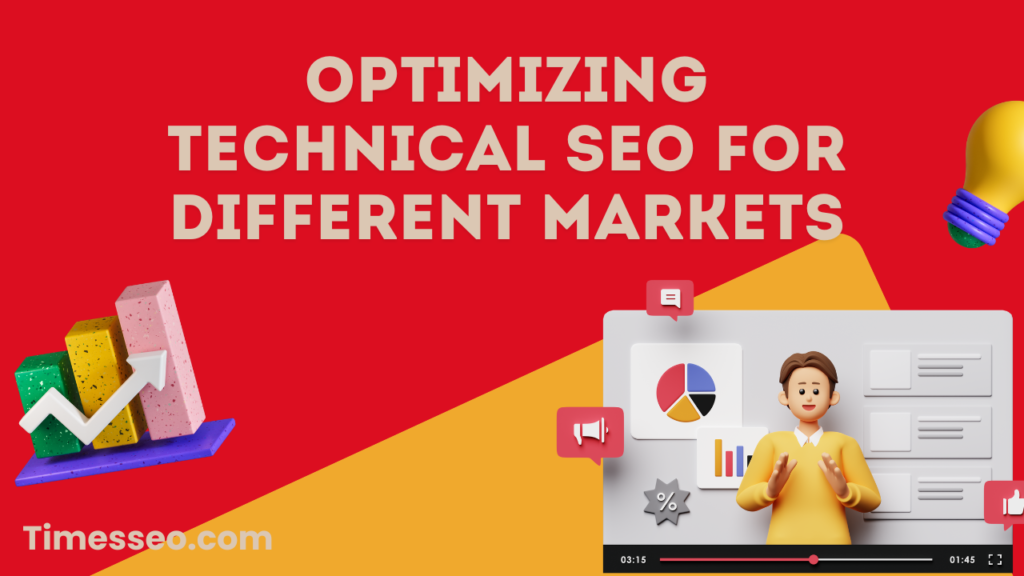
How Targeting Markets Increases Your Organic Traffic Fast
This blog post explores how targeting markets can significantly accelerate your organic traffic growth. By segmenting your audience based on location, behavior, and demographics, you can deliver more relevant content, improve engagement, and boost SEO performance. Learn strategic steps to tailor your SEO efforts and reach the right audience faster.
Table of Contents
Introduction
Here’s the trick if you’re trying to increase organic traffic but finding it’s stagnating: you’re most likely talking to everyone, which implies that nobody is responding to you. That’s where targeting specific markets changes the game. Instead of broad, generic content, a segmented SEO approach helps you get in front of the right people at the right time—which means faster growth, higher engagement, and more conversions.
Let’s break down how and why targeting markets can supercharge your SEO results.
Understanding Market Segmentation in SEO
What is market targeting in SEO?
Market targeting in SEO means tailoring your website content, keywords, and optimization efforts to specific groups based on factors like location, behavior, or needs.
Improved user experience
People stay longer, interact more, and convert when they feel heard. That’s SEO gold.
Benefits of segmenting your audience
Dividing your audience into manageable portions allows you to:
- Speak directly to their interests
- Build trust faster
- Solve their exact problems
- Guide them toward action more efficiently
Relevance and personalization
Generic content is like shouting into a void. Personalized content? That’s a conversation. When your pages feel like they were made for the user, they’re more likely to stick around.
Types of Market Segmentation for SEO
Geographic segmentation
Customize your SEO approach by city, neighborhood, or even region. Think: “best pizza in Brooklyn” vs. “best pizza in Chicago.”
Demographic segmentation
Target customers based on their age, gender, income, or level of education. For example, a skincare brand might optimize differently for teens vs. retirees.
Behavioral segmentation
Group users by their actions—what pages they visit, how often they return, and what content they engage with.
Psychographic segmentation
Tap into people’s lifestyle, interests, and values. A blog targeting eco-conscious moms will look way different from one targeting extreme sports enthusiasts.
Tools and Techniques to Identify Your Target Markets
Google Analytics and Search Console
Check out user location data, device usage, and top-performing content by country or state.
Audience insights tools
Use Facebook Insights, YouTube Analytics, or SEMrush to dig into audience interests and behaviors.
Surveys and user feedback
Find out what your visitors want, then provide it.
How Targeting Markets Boosts Organic Traffic
Keyword personalization per segment
Instead of targeting “best laptops,” aim for “best budget laptops for students in India” or “top laptops for video editing in the UK.”
Creating tailored content
Localized blog posts, region-specific landing pages, and targeted guides can drive traffic faster than generic posts.
Increased engagement and dwell time
People engage longer with content that feels like it was written just for them.
Lower bounce rates = higher rankings
Google notices when users stick around. More relevant content = better metrics = higher rankings.
Crafting SEO Content That Speaks to Each Market
Localized landing pages
These are essential. A page about “affordable SEO tools in Australia” should differ from one targeting the U.S.
Persona-based blog content
Build out content series for specific personas: e.g., “SEO for small business owners,” “SEO for realtors,” etc.
Cultural and regional keyword differences
In the UK it’s “trainers.” In the U.S. it’s “sneakers.” Know your market. Speak their language—literally.
Case Studies: Fast Growth via Market Targeting
A local business going national
A catering company optimized pages for each major city it served. Organic traffic grew 120% in 3 months.
International eCommerce example
A beauty brand localized its product pages for each region and doubled its organic conversions from Europe.
Optimizing Technical SEO for Different Markets
URL structure and hreflang tags
Use country-specific domains or subdirectories (e.g., /us/, /ca/, /in/) and hreflang tags to indicate language targeting.
Server location and CDN
Use content delivery networks (CDNs) to serve content faster in different regions.
Mobile optimization by region
Mobile performance varies by country. Optimize for connection speeds and devices common in your market.
Common Mistakes to Avoid When Targeting Markets
Overgeneralizing
“Asia” isn’t one market. Neither is “Europe.” Segment down to the country—or city—level where possible.
Ignoring data
Assumptions are expensive. Select your target audience based on real analytics.
Duplicate content issues
Don’t just copy-paste content with a different city name. Customize and localize properly.
Tips to Scale Market-Specific SEO Strategies
Create reusable templates
Use a proven page structure and swap in custom content for each region or persona.
Automate with AI tools
Create initial drafts of material tailored to a particular region using AI. Edit for quality.
Build local backlinks
Partner with local blogs, directories, or influencers to boost credibility.
Monitoring Results and Adjusting Tactics
What to track: CTR, bounce, rankings
Track performance by region and persona. What’s working where?
Monthly vs quarterly reviews
Don’t wait too long to optimize. Review your targeting performance at least monthly.
Pivoting based on performance
If a market’s underperforming, tweak the offer, test new keywords, or consider pausing until a better fit arises.
Future Trends in Market-Specific SEO
Hyper-personalization with AI
Expect AI-generated content based on real-time user behavior and preferences.
Voice search and localized intent
Speaking queries and “near me” searches are becoming more popular. Get ready for that shift.
Zero-click searches by segment
Target snippets and answer boxes tailored to your market’s FAQs.
Conclusion
Here’s the deal: targeted SEO strategies drive results faster because they’re focused, relevant, and user-first. By identifying your core markets and crafting content specifically for them, you’ll see your organic traffic climb faster than chasing generic keywords ever could. Start small. Segment smart. Grow fast.
Frequently Asked Questions
Start with localized landing pages based on your top traffic regions. Use Google Analytics to decide where to begin.
It depends on your audience. Start with 2–3 key personas or locations and expand as you see results.
Yes—duplicate content, incorrect hreflang tags, or poor localization can confuse search engines. Follow best practices.
Not at all. Local businesses benefit greatly from hyper-local targeting too.
You can start seeing improvements in 4–8 weeks if you target correctly and optimize well.
Table of Contents
Popular Posts
-
 Affordable Technical SEO Audit for Small Business: A Complete Guide26 Jun 2025 Blog
Affordable Technical SEO Audit for Small Business: A Complete Guide26 Jun 2025 Blog -
 How to Get an Affordable Technical SEO Audit for Small Business27 Jun 2025 Blog
How to Get an Affordable Technical SEO Audit for Small Business27 Jun 2025 Blog -
 The Ultimate Local SEO Audit Checklist for Startups28 Jun 2025 Blog
The Ultimate Local SEO Audit Checklist for Startups28 Jun 2025 Blog -
 Local SEO Audit Checklist for Startups: A Beginner’s Guide28 Jun 2025 Blog
Local SEO Audit Checklist for Startups: A Beginner’s Guide28 Jun 2025 Blog -
 Top On-Page SEO Audit Steps for Service Websites Every Business Should Know29 Jun 2025 Blog
Top On-Page SEO Audit Steps for Service Websites Every Business Should Know29 Jun 2025 Blog -
 Technical SEO for WordPress: The Ultimate Beginner’s Guide01 Jul 2025 Blog
Technical SEO for WordPress: The Ultimate Beginner’s Guide01 Jul 2025 Blog -
 The Impact of On-Page SEO Audit Steps for Service Websites on UX01 Jul 2025 Blog
The Impact of On-Page SEO Audit Steps for Service Websites on UX01 Jul 2025 Blog -
 Technical Mobile SEO Audit Tips for Developers02 Jul 2025 Blog
Technical Mobile SEO Audit Tips for Developers02 Jul 2025 Blog -
 Complete SEO Backlink Audit Guide for Better Google Rankings03 Jul 2025 Blog
Complete SEO Backlink Audit Guide for Better Google Rankings03 Jul 2025 Blog -
 Boost Your Rankings with Technical SEO for WordPress01 Jul 2025 Blog
Boost Your Rankings with Technical SEO for WordPress01 Jul 2025 Blog






